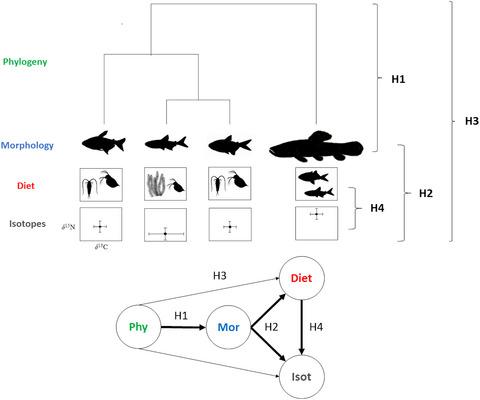当前位置:
X-MOL 学术
›
Ecol. Evol.
›
论文详情
Our official English website, www.x-mol.net, welcomes your
feedback! (Note: you will need to create a separate account there.)
Can ancestry and morphology be used as surrogates for species niche relationships?
Ecology and Evolution ( IF 2.3 ) Pub Date : 2020-06-03 , DOI: 10.1002/ece3.6390 Friedrich W Keppeler 1 , Kirk O Winemiller 1
Ecology and Evolution ( IF 2.3 ) Pub Date : 2020-06-03 , DOI: 10.1002/ece3.6390 Friedrich W Keppeler 1 , Kirk O Winemiller 1
Affiliation

|
Species interactions are difficult to quantify, and, consequently, many studies have used species traits and phylogeny as proxies under an assumption of niche conservatism (i.e., closely related and morphologically similar species should have similar niches). However, few studies have investigated whether niches actually are conserved within and across diverse communities. Here, we tested the degree to which phylogenetic relatedness and morphological similarity predict diets and stable isotopic ratios (δ 15N and δ 13C), two common descriptors of the trophic niche, in fish assemblages of two small streams in the Neotropics. We also tested the strength of the association between isotopic ratios and diet composition and found significant correlations implying that isotopic signals reveal trophic structure despite error associated with estimates of trophic enrichment and variation associated with tissue preservation, metabolism, and other factors affecting isotopic ratios. Morphological traits yielded a significant phylogenetic signal, and both morphological traits and phylogeny were correlated with diet composition, with morphological traits being a stronger predictor. We infer that functionally relevant morphological traits of fish can be used to infer trophic niches for certain kinds of questions and analyses when trophic data are lacking. However, we highlight that using phylogenetic and morphological data in combination with dietary and/or isotopic data can improve resolution of assemblage trophic structure and niche diversification.
中文翻译:

祖先和形态可以用作物种生态位关系的替代吗?
物种间的相互作用很难量化,因此,许多研究在生态位保守主义的假设下使用物种性状和系统发育作为代理(即密切相关且形态相似的物种应该具有相似的生态位)。然而,很少有研究调查生态位是否确实在不同的群落内部和之间得到了保护。在这里,我们测试了新热带地区两条小溪流鱼类组合中系统发育相关性和形态相似性预测饮食和稳定同位素比率( δ 15 N 和δ 13 C)(营养生态位的两个常见描述符)的程度。我们还测试了同位素比率和饮食成分之间关联的强度,发现显着的相关性意味着同位素信号揭示了营养结构,尽管与营养丰富度的估计以及与组织保存、代谢和影响同位素比率的其他因素相关的变化相关的误差。形态特征产生了显着的系统发育信号,形态特征和系统发育都与饮食成分相关,其中形态特征是更强的预测因子。我们推断,当缺乏营养数据时,鱼类的功能相关形态特征可用于推断某些类型问题和分析的营养位。然而,我们强调,将系统发育和形态学数据与饮食和/或同位素数据结合使用可以提高组合营养结构和生态位多样化的分辨率。
更新日期:2020-07-25
中文翻译:

祖先和形态可以用作物种生态位关系的替代吗?
物种间的相互作用很难量化,因此,许多研究在生态位保守主义的假设下使用物种性状和系统发育作为代理(即密切相关且形态相似的物种应该具有相似的生态位)。然而,很少有研究调查生态位是否确实在不同的群落内部和之间得到了保护。在这里,我们测试了新热带地区两条小溪流鱼类组合中系统发育相关性和形态相似性预测饮食和稳定同位素比率( δ 15 N 和δ 13 C)(营养生态位的两个常见描述符)的程度。我们还测试了同位素比率和饮食成分之间关联的强度,发现显着的相关性意味着同位素信号揭示了营养结构,尽管与营养丰富度的估计以及与组织保存、代谢和影响同位素比率的其他因素相关的变化相关的误差。形态特征产生了显着的系统发育信号,形态特征和系统发育都与饮食成分相关,其中形态特征是更强的预测因子。我们推断,当缺乏营养数据时,鱼类的功能相关形态特征可用于推断某些类型问题和分析的营养位。然而,我们强调,将系统发育和形态学数据与饮食和/或同位素数据结合使用可以提高组合营养结构和生态位多样化的分辨率。











































 京公网安备 11010802027423号
京公网安备 11010802027423号